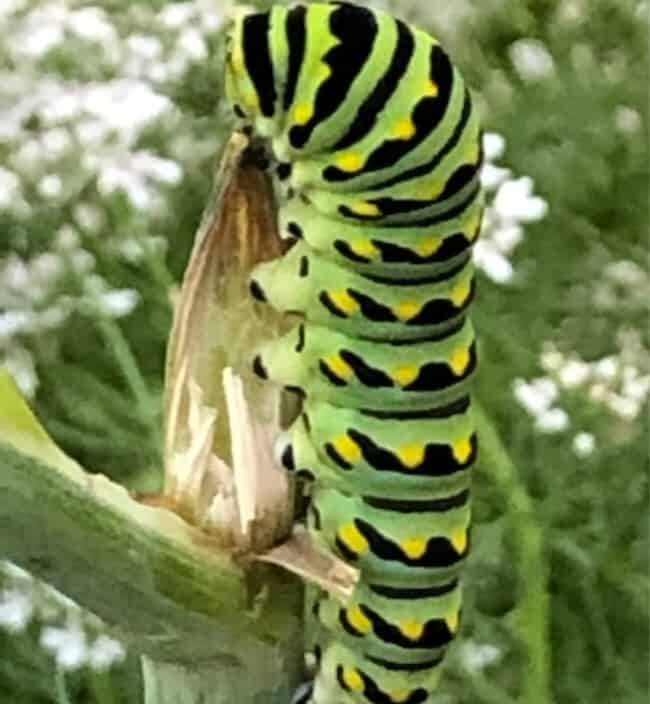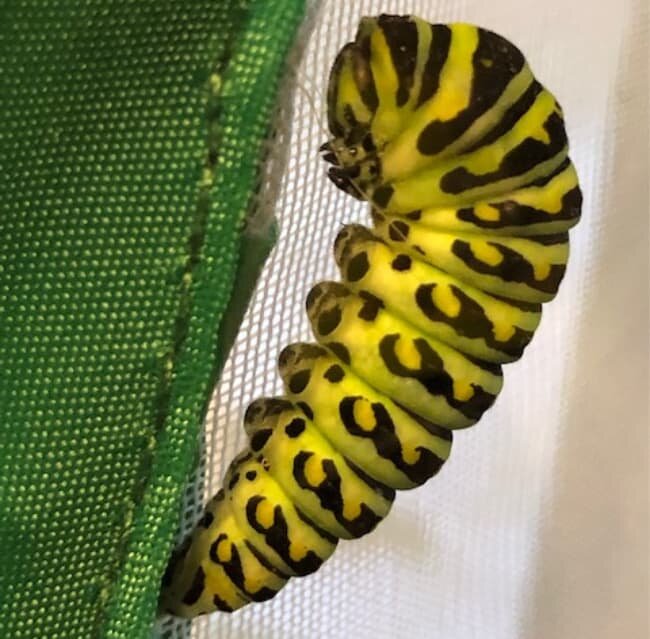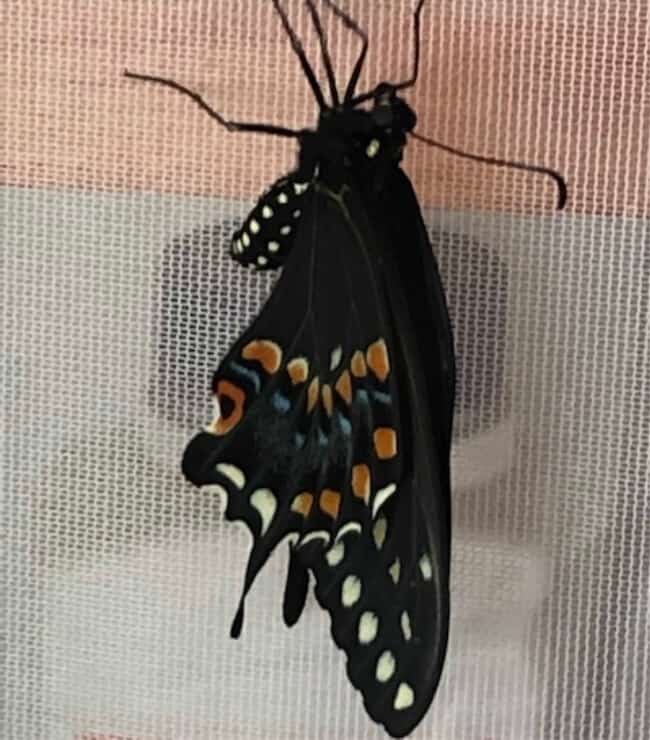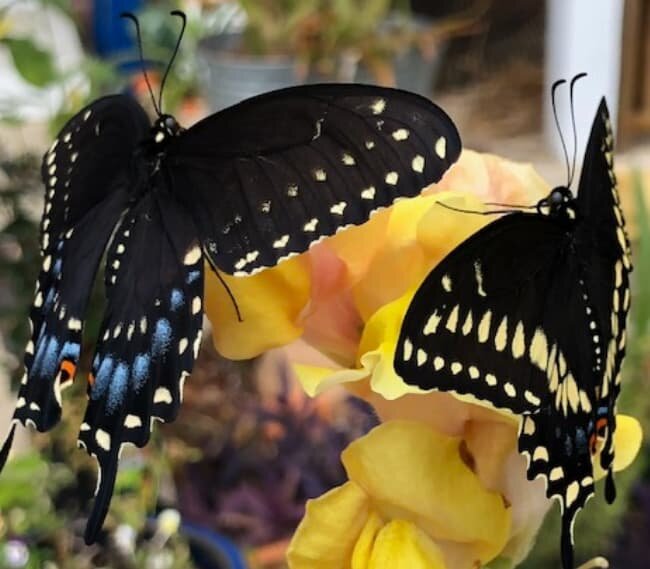Lessons Learned in my First Year Raising Eastern Black Swallowtails
If you’ve been around for awhile, you may remember my post from a few weeks ago about my first season raising monarchs and the lessons I learned. If not, you can find my Raising Monarchs post here.
I also ended up raising a couple of generations of Eastern Black Swallowtails this summer, and I’ve gotta tell you, they’re totally different from monarchs!
You might be saying, a caterpillar’s a caterpillar or a butterfly’s a butterfly, they can’t be THAT different! Oh, hang on for a minute and let me explain to you why monarchs are from Mars and swallowtails are from Venus (or is it the other way around? Well, anyway, you get the idea).

Swallowtails Are Easier to Raise than Monarchs
By this I mean, swallowtails, at least in this part of the country, don’t seem to be as susceptible to either predation or disease as their monarch counterparts.
I raised more than 125 monarchs this year and only 30 swallowtails, so I may not be completely accurate in this. BUT, I haven’t lost a single swallowtail to either disease or predation, and I lost multiple monarchs.
Both are *technically* susceptible to both tachinid fly infestation and chalcid wasp parasitization, but none of my swallowtails suffered either one.
Now, I did bring my second batch of swallowtails in as eggs, so that may have something to do with it, but the first batch came in as larger caterpillars (3rd to 4th instar, I believe), and so far, 17 of the 20 chrysalides have emerged as happy and healthy butterflies.
This brings me to my next point.
Swallowtails Follow Their Own Schedule…

he’s also attached at the very bottom
…..and I’m really not sure what that is!
All 20 of my first generation swallowtails went into their chrysalides within a week of each other. Seventeen of them then emerged within 11 days of each other. Not too bad, right?
I’ve still got 3 sitting up there in my enclosure not doing anything but sitting there. Does that mean they’re dead? Nope, not at all. They *may* come out before winter, they *may* decide to overwinter and come out in the spring, and they *may* decide to wait an extra year!
Yup, swallowtails have their own schedule and we mere humans can’t figure it out!
Some people say the green chrysalides will always come out the same season, and the brown ones will overwinter. Well, all my green ones did come out this season, but I had several brown ones come out as well, while I still have 3 brown ones sitting up there.

the butterfly is almost ready to come out, you can see the wing markings!
About the only constant with these guys is that they’ll come out when they’re good and ready, and not before!
Whereas monarchs almost always emerge from their chrysalides in the morning to early afternoon, again, swallowtails didn’t get the memo. I’ve had them emerge late in the evening, and I believe, even overnight! They really march to the beat of a different drummer!
Swallowtails Don’t Eat Nearly as Much as Monarchs
As you know, monarchs will only eat milkweed. Milkweed, particularly common milkweed, has large leaves that *should* (at least you would think so) last a long time. Um, nope! A couple of caterpillars can chomp through a good-sized clump of milkweed almost before you can blink.

through it in an hour!
The funny thing is, Eastern Black Swallowtails feast on dill, parsley, Queen Anne’s lace, and fennel. These are all rather lacy and seemingly insubstantial plants, yet they don’t eat as much of them as the monarchs do of the milkweed.
My current caterpillars are growing like weeds and I only have to replace their plants every few days, whereas the monarchs needed new munchies once or twice a day!
Swallowtails Have their Very Own Personalities….
….And crazy, stinky horns called osmeterium they like to use for protection, even if they’re just protecting themselves from you!
The first time I went to move a swallowtail caterpillar and it stuck those crazy orange horns out at me, I couldn’t believe it! No one warned me they did THAT!

Warning: If you raise them, know that the osmeterium get VERY stinky as the caterpillars get older. Some people don’t seem to mind the smell, but I think it’s pretty icky, and once they stick those horns on your skin, the smell lingers, even after you wash, and wash, and wash again.
Even the tiniest caterpillars have osmeterium, and they’re completely adorable. Here’s this teensy, tiny little caterpillar rearing up and trying to “scare” me with horns approximately 1/16″ long. Ha! It makes my day! Wish I could get a pic of them at that stage, but they’re too small.
It’s funny also, how the caterpillars have their own unique personalities. I mean, they’re just insects, right?
Yet, I’ve had a few whom I can move all over the place and hold and whatnot, and they never, ever stick out those crazy horns. Then, I’ve got others who stick them out as soon as I walk by the enclosure. I’m totally not kidding, I swear they smell me or something and out come the horns. Hmmmm…..does that mean I need to shower more?
Swallowtail Butterflies are Eager to Get Going!

As I mentioned above, monarchs tend to come out of their chrysalides in the morning to early afternoon, whereas swallowtails will come out whenever they darn well please.
Sometimes this is fine, as they can be released about 2 hours after emerging. However, if the weather isn’t good (rainy, windy, chilly), newly emerged butterflies shouldn’t be released because they won’t be able to fly well.
This isn’t a problem with monarchs. I’ve kept them in my enclosure for over 24 hours when the weather was bad, and they just kind of hung out and stayed chill and happy until I let them out.
Swallowtails? Not so much! They’re crazy children! They want OUT! Like, 6-year-old stuck in school all day at recess time, OUT!

An additional problem here is that swallowtail wings are more delicate than monarchs, and they can damage themselves if they fly too vigorously around the enclosure and thump their wings into the netting too much.
I haven’t had any serious problems yet as we’ve had very little rain this summer, but if you live somewhere that it rains a lot during the summer, you might want to think twice before raising swallowtails.
Monarchs or Swallowtails, Which Should I Raise?
Honestly, I love them both. But, if you need to pick (assuming you have both where you live) and you’ve never raised before, I would definitely suggest swallowtails.
Now, I can’t speak for the many other species of swallowtails, but the Eastern Blacks are just so easy!
If you have kids, they’re going to love those crazy orange horns! The other neat thing with swallowtail caterpillars is that they start out looking so different from the way they look right before they pupate. Your kids will have a blast watching them!

The combination of better overall health, (probably) easier procurement of food, funky appearance, and those super cool orange horns make swallowtails the clear winners!
That said, will I raise monarchs next year? Heck yeah!! But I’ll definitely raise Eastern Black Swallowtails, and plans are in the works to find some of the other 6 species native here in CT and raise some of them too!
I hope you’ve enjoyed reading today’s post as much as I’ve enjoyed this season with my butterflies! You’ll find some pinnable images below. Please pin them to your Butterflies or Beneficial Insects board on Pinterest for later reference.
Otherwise, thanks for reading, smile and have a crazy organic day!
Posts Related To Raising Swallowtails
- Raising Monarchs
- Shrubs and Bushes to Attract Pollinators
- Creating a Butterfly Garden
- Biological Diversity in the Garden




15 comments
Hi Dawn,
Have you tried raising the pipevine swallowtail? This is an interesting species that occurs in your area and the larval hostplant Aristolochia durior is a beautiful garden plant.
I haven’t yet. I’ve only done Eastern Blacks so far but am trying to plant more host plants to hopefully attract more species. I have Tigers but they’re using my Tulip poplars and the trees are too big for me to collect eggs or cats.
I live in Wisconsin, it is now September 30th. A few weeks ago I noticed these big caterpillars chomping on my parsley plants. Wasn’t exactly sure what they were so I brought them in and put them in a jar with some parsley. They devoured that. Put in some more parsley and cleaned the bottom of the glass. After Identifying them online, I put in some more parsley and a couple sticks for them to climb on. They crawled up them and went into chrysalis. It’s been about 2 weeks and one of them has come out. Now I am not sure what to do with it. It’s going to be in the 50s here tomorrow in Wisconsin. I keep thinking that maybe I shouldn’t have interfered with mother nature. It is in an enclosed space and has not done very much at all.
It’s likely that the ones you have left will overwinter. Swallowtails have their own timeframe for doing things so some will come out right away and some will wait. I place my overwintering chrysalides in an aquarium with a metal mesh lid and leave it on my covered but open front porch. Don’t keep them in the house, warm temps will cause them to possibly come out in the middle of winter. If you’d rather not keep them over the winter, attach the stick they’re on to a tree or bush in your yard and let nature take care of things. I hope that helps. Let me know if you have other questions. There’s a Facebook group called Raising Swallowtails that is a great resource as well.
As for the butterfly that emerged, just let it go, preferably on a sunny day. It’s a bit late in the season for it, but that happens sometimes.
I’ve raised about every type of butterfly & moth that I could find here in Missouri. The black swallowtails are one of my favorites as well. I did get parasitic wasp hatching from several chrysalids one year, so now I bring them in as eggs if possible. No problems since then. I raise monarchs because I think they need the help, but between tachinid flies and “Black Death” they’re a much bigger pain and commitment. Polyphemus moths are one of my favorites as well, but like the black swallowtails you never know when they’ll emerge.
It has certainly been an adventure raising these guys this year! I haven’t tried the Polyphemus moths yet, but I’ve planted a much wider array of pollinator-attracting species for this coming summer, so I’m hoping to have some new species to work with. I was really fortunate with the monarchs this past summer, not having lost too many, although I did lose a few towards the end of the season. It seems that disease pressure definitely increases late in the season, as it does with most everything growing, whether animal or plant. Please keep us posted on your butterfly raising efforts!
Question: Do Swallowtails return to their place of birth? I’ve seen some conflicting stories – some say yes, some no.
I’m actually not sure on that. Sorry.
How neat that you did a comparison! I had no idea that they’d act any differently, besides eating different foods.
🙂 gwingal
They’re very different. Totally different personalities. Who knew, right? Bugs can have personalities!
So beautiful! My kids are fascinated with your pics! Were they in a terrarium or did they roam free in your house?!?
They were in a mesh enclosure. I have 5 (furry) cats so they couldn’t be loose anywhere. Plus, they’re really good at hiding so having them enclosed is safest for them.
Dawn that was very very informative and interesting
Thank you!